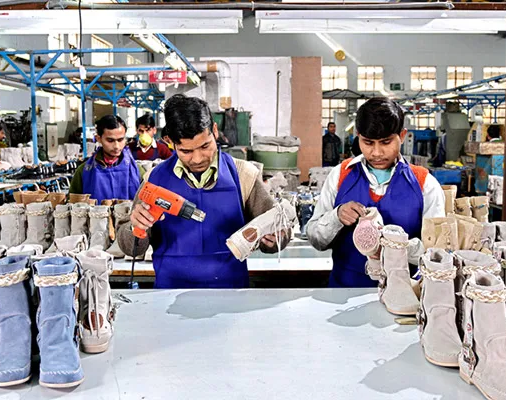Small shoe factories in India make up the largest slice of the industry but, according to moneycontrol (PK Krishnakumar Jan 04, 2022), footwear has become more expensive in the new year following an increase in the tax rate on goods and services and higher commodity prices. Manufacturers and retailers expect a decline in demand for footwear that could hurt their business.
GST on footwear below Rs 1,000, which accounts for most of the production, has increased to 12 percent from 5 percent previously. The tax on footwear above Rs 1,000 was unchanged at 18 percent.
The Confederation of Indian Footwear Industries anticipates a demand squeeze because of the increase in raw material prices and the higher tax rate. Reduced demand may lead to underutilization of manufacturing capacity, which will adversely affect the sector.
“Already, footwear prices have gone up by about 20 percent in the past one year on account of steep increase in prices of raw materials,” said V Noushad, MD of Walkaroo International, who is also vice president of CIFI. “In addition to this, the revised 12 percent GST implemented from this month will create a significant impact on demand, affecting the footwear segment.”
The prices of some raw materials used in footwear making have increased by 50 percent. Their production shrank during the shutdown and when operations resumed, there was a severe shortage of these inputs.
CIFI reckons that the higher GST rate may encourage unofficial sales – without any bills issued. At the earlier 5 percent rate, most of the trade was carried out by paying the full tax. At 12 percent, unofficial sales may increase and keep the net recovery flat, making the higher GST rate counter-productive, according to the confederation.
The GST Council increased the rate on footwear below Rs 1,000 to remove an anomaly of higher tax on raw material than on finished products.
Although the footwear industry boasts of big names such as Bata, Relaxo, Paragon, Walkaroo, Liberty, Campus and Action, the market is dominated by small players in the unorganised segment.
According to Noushad of Walkaroo, footwear below Rs 1,000 accounted for 85 percent of the total production.
“About 70 percent of footwear production is by small manufacturers employing 5-50 workers in small houses,” Noushad said. “They will not be in a position to pay the 12 percent tax. Either they will start doing cash business as before or will close down.”
The GST rate hike will hit retailers and small manufacturers more than the big ones, according to Sajan Alex Mathew, associate vice president of Paragon.
“The retailers will lose margins if they don’t hike footwear prices. The impact will be less on big manufacturers for whom the higher GST will be set off against 18 percent input taxes,” he said.
Mathew said many small manufacturers had to quit the business or are on the verge of closure because of a working capital crunch due to delays in GST refunds, which can take about two years.
The increase has come just as sales have started picking up after a lull caused by Covid-19. Demand for low-cost footwear increased after the pandemic.
“More people seem to prefer footwear below Rs 500. The pandemic saw a rise in sales of Hawaii or rubber footwear that retails for about Rs 150,” said Shibu MB, a consultant for Lunar’s Footwear.
Non-leather footwear accounts for 90 percent of the market, according to a study by management consultancy firm Krysalis. About one-third of the production is polyurethane footwear, followed by Hawaii slippers and sports shoes.
More than 10,000 non-leather manufacturers operate in India, a majority of them unorganised. The major manufacturers are spread across clusters in Bahadurgarh, Delhi, Kozhikode, Kolkata, Agra, Ambur and Chennai. The footwear industry employs more than 3 million people.
According to Krysalis, the Indian footwear industry was worth $10 billion in 2020 and it is expected to grow 10 percent over the next decade.
With 3 billion-plus pairs sold in 2020, the current per capita consumption of footwear in India is 2.3 pairs, while the global average is 3.2 and the developed country average is more than six pairs. Increased purchases of casual and sportswear globally is expected to fuel the growth of non-leather footwear.
Even disposing of stock made in 2021 that’s lying with traders and retailers with a 5 percent GST rate will be a problem. They will have to be sold at a discount to accommodate the increased GST of 12 percent at the same retail price, which could result in revenue loss for retailers.



